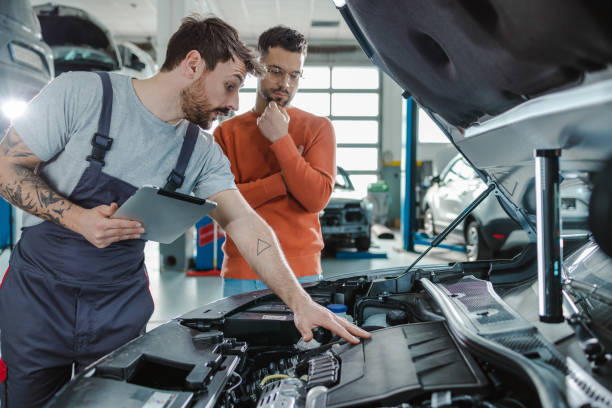Car Diagnostic Birmingham:
Every vehicle owner, at some point, encounters a moment when the check engine light appears, the car starts making unusual noises, or performance suddenly drops. When that happens, a professional Car Diagnostic Birmingham and repair session becomes essential. But what goes on during that process? From initial consultation to final road tests, this blog breaks down each step involved in diagnosing and repairing your car, so you know what to expect when you visit a reputable auto garage.
Understanding the Importance of Diagnostics:
Modern vehicles are essentially computers on wheels. They’re equipped with complex electronic control units (ECUs) and dozens of sensors that monitor everything from engine performance to exhaust emissions. A car diagnostic session is how professionals tap into this system to find out what’s going wrong.
Rather than simply guessing the issue based on symptoms, a diagnostic test helps pinpoint the root cause, saving both time and money in the long run. It prevents unnecessary part replacements and ensures the actual problem gets resolved.
Step 1: The Initial Discussion
The diagnostic process begins with a conversation between you and the mechanic. You’ll be asked to explain what problems you’ve been experiencing. This might include details like:
- When the issue started
- Whether it occurs continuously or intermittently
- Any changes in performance or strange sounds
- Recent services or repairs done on the vehicle
This information provides technicians with clues that guide their inspection and testing.
Step 2: Visual and Manual Checks
Before hooking your car up to a diagnostic machine, a trained mechanic will usually carry out a manual inspection. This includes checking:
- Battery condition and terminals
- Condition of hoses, belts, and spark plugs
- Signs of leaks or physical damage under the hood or chassis
Manual checks can reveal obvious problems, like a cracked hose or leaking gasket, which might be causing the issues.
Step 3: Connecting the Diagnostic Tool
Once the preliminary inspection is done, technicians will use a diagnostic scanner. This is a device connected to the vehicle’s onboard diagnostics (OBD-II) port. The scanner communicates with the vehicle’s computer systems and retrieves stored error codes, which indicate which component or sensor is malfunctioning.
Each error code corresponds to a specific issue—whether it’s with the transmission, fuel system, oxygen sensor, catalytic converter, or even minor faults like a loose gas cap.
The technician interprets these codes using experience and repair manuals. In some cases, the codes are just the starting point, and more in-depth testing is needed to confirm the exact problem.
Step 4: Additional Testing
If the error codes don’t provide a conclusive answer or if the mechanic suspects a deeper issue, further testing may be performed. This might include:
- Compression tests to evaluate engine health
- Fuel pressure tests to check the fuel pump function
- Electrical system analysis to find shorts or poor connections
- Smoke tests to locate vacuum leaks in the intake system
These additional tests are crucial for complex issues that aren’t immediately obvious or involve multiple interconnected systems.
Step 5: Diagnosing Intermittent Issues
One of the more challenging aspects of diagnostics is dealing with issues that don’t occur consistently. If the problem doesn’t happen while the car is in the workshop, mechanics may keep it for further observation or test drives. They may also use live data logging tools to monitor sensor activity during driving conditions, enabling them to catch problems as they arise in real-time.
Step 6: The Repair Process
Once the root cause is identified, the repair process begins. Depending on the problem, this could range from something simple like replacing a faulty sensor to more complex tasks such as:
- Replacing a timing belt
- Repairing or replacing a transmission
- Overhauling a braking system
- Reprogramming the ECU or updating software
During this phase, a reputable garage will communicate openly with you about what needs to be done, how long it will take, and the estimated cost.
Step 7: Final Checks and Test Drive
After repairs are completed, the technician will clear the error codes from the system and rerun the car to ensure the issue has been resolved. A test drive is usually done to verify that everything is working as expected and no new problems have emerged.
Preventive Benefits of Regular Diagnostics
Even when your car appears to be running fine, periodic diagnostic checks can identify minor problems before they become expensive repairs. For instance, slight drops in fuel efficiency or undetected sensor issues can be spotted early, helping you avoid a breakdown later on.
Many modern service centres now offer diagnostic checks as part of their routine service packages, providing peace of mind to vehicle owners.
Final Thoughts:
Professional car diagnostics and Car Repair Birmingham are far more than just “plugging in a scanner.” It’s a thorough process that combines technology with skilled craftsmanship. By understanding what goes on during a diagnostic and repair session, you can make informed decisions about your vehicle and appreciate the value of expert service.








